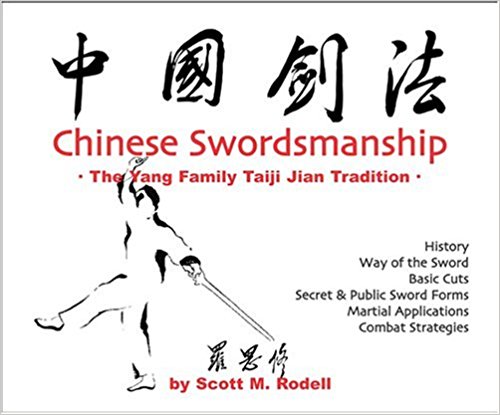I have been studying such an interesting book: Chinese Swordsmanship, by Scott Rodell.

Rodell describes two systems of swordfighting, both attributed to Yang Luchan (1799-1872), the founder of Yang-style Tai Chi and of the Yang sword form. During the early years of his career (mid-nineteenth century) Yang Luchan kept his swordfighting techniques secret. That Yang system, and the sword form that demonstrates it, Rodell calls the Michuan system.
秘传 Mìchuán: “secretly transmitted, esoteric lore”
The Yang sword form most of us are familiar with, which Rodell calls the public form, was a later development. The Michuan system has eight named swordfighting techniques (剑法 Jiànfǎ). The public form has thirteen.
This clears up a mystery for me: I had always heard there were thirteen essential swordfighting techniques, yet the Chen masters seem to name only eight and the Wudang masters nine. So apparently, the number of Jiànfǎ depends on what system you’re talking about; it is the Yang sword system that has thirteen.
There is still plenty of room for confusion (on my part) and further study. In some cases the same technique has different names in different systems; in other cases, the same name attaches to different techniques in different systems. Rodell does include a chapter on other swordfighting systems, though it is not exhaustive by any means.
The Yang techniques are: dian, ci, pi, beng, ya, chou, dai, ti, ge, ji, jiao, jie, and xi. Rodell describes how each is executed, and while I don’t suppose it’s possible to learn the techniques entirely from these descriptions, they are very useful.
What is also helpful is the way he categorizes the different techniques, beyond the obvious distinction between attacking and defensive maneuvers. He describes the Jiànfǎ in terms of long, medium, or short energy, the part of the sword being used, and the part of the body targeted.
Rodell also sorts Jiànfǎ by cutting method, of which there are four: deflect or neutralize; straight thrust to pierce; what he calls a “percussion cut” (a chop with the edge of the blade without a lateral draw); and slicing cuts that draw or push the edge lateral to the cut. Hitting with the flat of the blade is in a miscellaneous category of additional “minor movements” not really part of the system.
The book includes step-by-step illustrations and descriptions of the both the Michuan and public sword forms. It is particularly illuminating is that he provides the applications for each movement. In many, if not most cases, a single named movement involves multiple techniques.
I particularly like the way Rodell relates the sword forms to the use of the sword in actual battle, and the historical material makes very good reading. He even briefly comments on the comparison between Chinese and European swordsmanship. Between the definitions of the techniques, the applications, and the illustrations of how to do the form, history, philosophy, metallurgy, and accounts of Rodell’s own extensive training experience, this is quite a dense book, more a reference or text than a cover-to-cover read. Excellent book, a great find —highly recommended!
